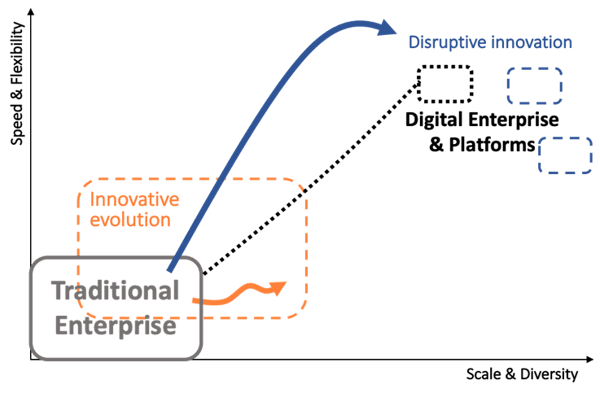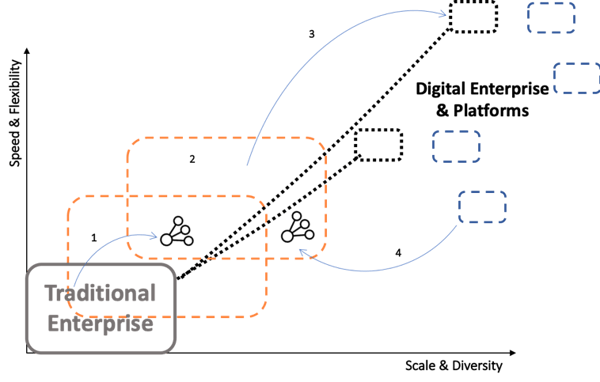Platform engineering
Ensuring your business a flourishing future: how to and what's the role of platforms and ecosystems in this journey?

In my previous blog I explained why it is important for any organisation to think about its ecosystem and develop a platform strategies. I’ve dived deeper into the two main platform strategies. Developing a strategy is one thing, at least as challenging it is, to implement it and secure one’s position in the platform business of the future.
Digital businesses and platforms are more flexible, scalable and adaptable to changing customer expectations. Recent studies from McKinsey and cio.com acknowledge the importance. Traditional enterprises ask themselves how they can transform to a platform business or claim their place in this new kind of business?

How to claim your position in the digital platform business?
Most companies do this by directly trying to disrupt their own business or by launching incremental innovation initiatives. They choose to organize innovation workshops or set up an innovation generation process. Ideas coming out of such a process range from launching a new peer to peer lending platform, a cryptocurrency etc. This type of initiatives are represented by the blue arrow in the figure. Another way is by trying to evolve to the future organization by incremental innovation. Examples are banks trying to digitize their processes as much as possible, coming up with the most user-friendly banking app etc. This is represented by the orange arrow in the figure.
How to succeed?
The approach above brings different challenges. Firstly, trying to come up with the next disruptive idea yourself without having a well thought data -based monitoring system of what is going on in the ecosystem of your customers is really hard, expensive and inefficient. As the following academic paper shows, only 1 out of the 3000 ideas makes it to a commercial success. Secondly, trying to evolve to a future proof organisation based on incremental innovation without a clear goal and strategy on how you can capitalise on your evolution is way to slow, entails the risk of you not going fast enough and lagging behind more and more.
A much better way to reach the target future state is combining the two platform strategies: product/service platformization and ecosystem orchestration that I described in the previous blog. Combining the two strategies in such a way that your transformation journey becomes an ever-growing virtuous circle, leads to a situation where the hard, expensive and risky work is actually done by the different players in your ecosystem while you can focus on capitalizing on the insights derived from the ecosystem. What does this approach look like exactly?
Product/service lifecycle
Let me start by stating that, as described very well by Wardley in the following blog, every product or service evolves during its lifecycle from something new - which is still exploratory and risky - to a commodity which is highly standardized, and thus no longer differentiating. Just think of the computing power. The first computers came in different forms and shapes such as the abacus, calculator, mechanic computer, mainframe etc. to eventually get to today’s computers or computing power which can almost unlimited be rented from the internet. Once something becomes a commodity, new higher order systems can be built upon that commodity. In the example of computing power, a new higher order system built on commoditised computing power could be intelligent agents.
Back to the virtuous ever-growing circle. It starts with “crown jewel mining”: the process to identify and create a steady flow of capabilities which are best fit and next in the row to be commoditized and to build a platform around it, encourage the usage of the product or service. On the platform you capture data and insights helping to improve continuously, sense what is successful and anticipate future needs in your ecosystem.
Timing is key
Copying or acquiring disruptive ideas at the right moment is much more efficient and effective than trying to come up with them by yourself. For disruptive innovations you want to be a fast follower. For commoditization you need to be first, otherwise you lose. That is why starting with capability mining is so important, because you don’t want your business or your core capabilities to be commoditized by others.

The picture here above gives a visualization of the approach. Let’s illustrate this using the Apple example from the previous blog. Soon after launching the iPhone, Apple decided to externalize its mobile app development capability, an illustration of product/service platformization. They turned their internal mobile app development capability into an external highly standardized mobile app development capability which anyone interested can build apps on for the iPhone.
Next, they capitalized on it by launching App Store, which is a perfect example of ecosystem orchestration. Apple only facilitates the matching and transactions between makers/sellers and buyers/users of mobile apps. These two movements are illustrated by arrows 1 and 2 in the figure. By getting insights of the usage of these platforms of what is happening in the ecosystem Apple is able to predict which new, next level platforms should be launched. Look at the Apple Music streaming platform for example. Thanks to their platforms, they noticed the success of Spotify and its peers on time and came up with their own alternative. This is illustrated by arrow 3 in the figure. This is a perfect illustration of letting the ecosystem innovate for you and getting in at the right moment.

To close the virtuous circle, a company following the approach proposed could also start better predicting what next capability should be commoditized and make the crown jewel mining itself much more efficient. This is visualized by arrow 4 in the figure. Apple Pay is an example of using insights from its current platforms, to predict with higher accuracy when it is the best time to enter the payment market. Now the launch Apple Card, a new generation payment card for the digital era. And so it goes on …
Get the process going
Getting this virtuous circle going and maintaining it, will increase steadily your company’s rate of innovation, customer focus, efficiency and return on investment. All of this will grow with the number of participants in the ecosystems your platform enables, the amount and depth of the insights gained from the ecosystem and the ability to react fast on these insights.
In the next blog, I’ll provide a better and more detailed view on the capabilities you need to apply and implement this approach. Follow us on social media.
Or just reach out to us via inspire@ae.be for a deep-dive conversation on your platform strategy.








